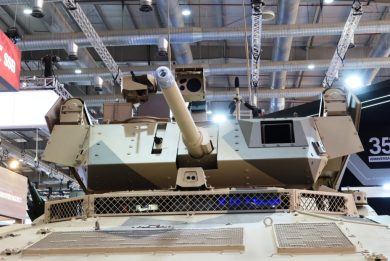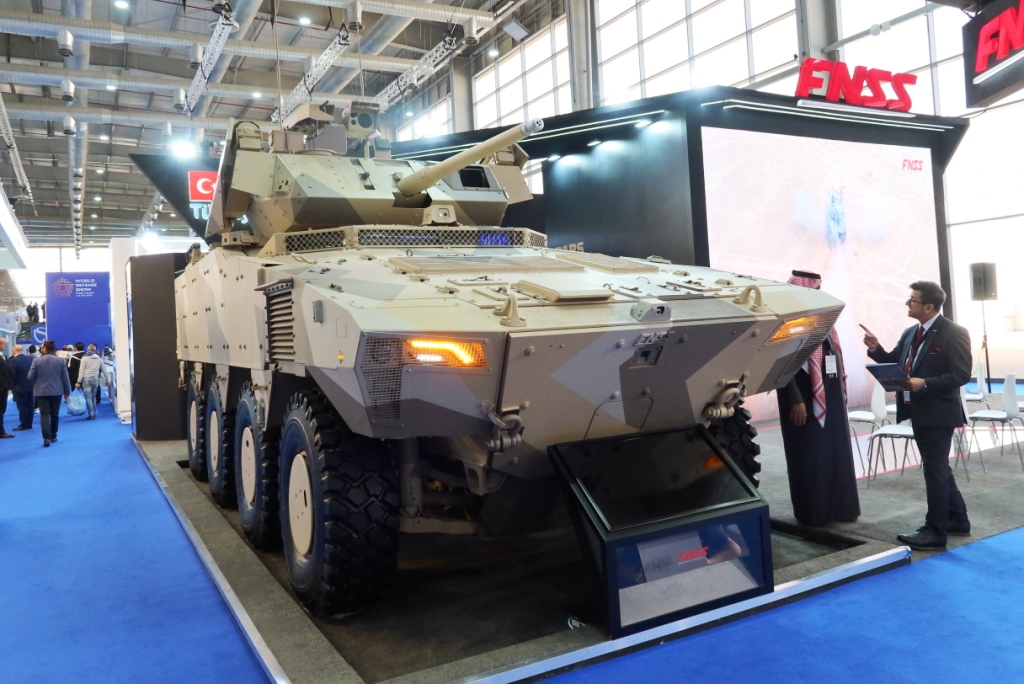
WDS 2024 – FNSS unveils its PARS ALPHA 8×8 New Generation AFV
At the second edition of the World Defense Show, the defence exhibition taking place in Riyadh 4 to 8 February, FNSS of Turkey unveiled the latest iteration of its PARS family, the PARS ALPHA 8×8, a wholly new vehicle designed to improve performances in all domains
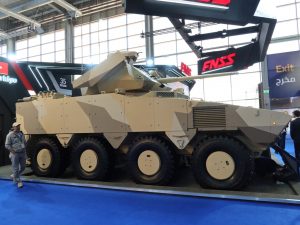
With the aim of continuously improving its products FNSS, the JV between Nurol and BAE Systems, unveiled at the World Defense Show the next generation of its PARS 8×8, named PARS ALPHA 8×8. This follows the PARS IV 8×8, which was launched at IDEX 2021 in August that same year, after two years of development. According to Nail Kurt, FNSS CEO and General Manager, the new vehicle is based on 20 years of company experience in armoured vehicles as well as on requirements from customers, first of all Turkish Land Forces. “The PARS ALPHA represents the answer to full spectrum dominance and represents the future of military engagement,” he stated, underlining increases in tactical mobility, survivability and firepower in smaller and lighter platform compared to its predecessor.
While keeping the 180°+ field of view for the driver and commander, who sit side by side and can exploit the wide ballistic glass windscreen to have full situational awareness on the frontal arc, the PARS ALPHA allows both of them to have direct sight with the dismounts in the rear. This comes thanks to the peculiar vehicle architecture; the very compact powerpack that provides 711 hp and is coupled to a fully automatic 6-speed transmission with one reverse gear, is located at the very front of the vehicle over the first axle, while the driver and commander are seated side by side over the second axle, which also increases crew safety, the gunner being seated behind the driver on the left side when an unmanned turret solution is adopted.
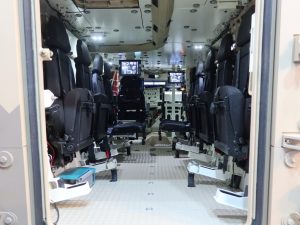
Having direct view with the dismounts in the rear compartment without any obstacle, which improves coordination in the most critical phases when infantry debusses and gets back on the vehicle. In the standard AFV configuration the PARS ALPHA 8×8 can carry nine dismounts each on his energy absorbing seat, who access the vehicle via the rear ramp; personnel are seated looking inwards, four seats being on the left and five on the right, scaled to allow better space for legs. An empty space is available on the right of the gunner, which can host extra equipment. Displays allow all on-board personnel to see the feed provided by the 360° situational awareness system.
According to data provided by FNSS the PARS ALPHA maintains the same width of the PARS IV, 3.1 metres, but is shorter, 7.8 versus 8.4 metres, which results in 7.8 metres turning radius versus 8.5 metres of the previous generation PARS, a key factor especially when operating in urban areas, both vehicles having all wheel steering. Not only, the new architecture allows increasing the internal protected volume compared to the PARS IV, according to the company. As for height, here too the PARS ALPHA is more compact when fitted with the remotely controlled turret; compared to the 2.5 metres of the PARS IV the new vehicle is 2.4 metres high on road. However, being fitted with independent, double wishbone, hydro-pneumatic suspensions with ride height control, its overall height can be reduced to 2.2 metres in transport configuration, while when travelling in areas potentially infested by mines or IEDs suspensions can be trimmed to maximum height ensuring a ground clearance of 600 mm, further improving blast protection. The PARS ALPHA is fitted with 16R20 tires, the same as PARS IV. The limited front and rear overhang ensure angles of approach and depart of 55°, the vehicle being able to cope with a 0.8 metre vertical obstacle, slightly more than the previous generation PARS, while trench crossing is the same, 2.4 metres. The different location of the engine and of its cooling grill reduces the fording depth from 2.1 to 1.2 metres in standard operating configuration, that can be increased to 1.5 metres exploiting the height adjustable suspensions. The decrease in the fording capacity is due to the presence on the left side of the cooling grid; should a customer require i.e. greater fording capability designs are already present to move it on the top, however this looks unlikely.
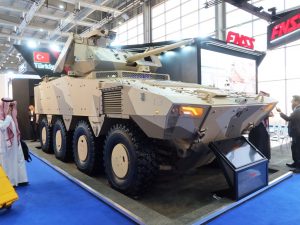
The PARS ALPHA features considerably improved performances in terms of gradient and side slope, 70% and 40% versus 60% and 30%. A combination of extra specific power, 21 hp/t versus 19 hp/t and lower centre of gravity might well be the two key elements for these improvements. The PARS ALPHA can also reach a higher speed on road, 115 km/h versus 100 km/h, creep speed remaining 5 km/h, while range is 800 km. Trials have shown that the PARS ALPHA can run for 5,000 km without need on maintenance, decreasing the logistic footprint and increasing operational readiness.
Although FNSS seldom provides the Gross Vehicle Weight (GVW) of its armoured vehicles, considering the engine output and the power-to-weight ration the PARS ALPHA GVW falls around 34,000 kg; no comparison can be made with the previous generation vehicle, however the data should not differ much, but the reduced length and improvements in materiel should have allowed FNSS to increase protection levels both ballistic and blast, these remaining however classified. The vehicle is fitted as standard with overpressure CBRN protection system, air conditioning and heating system, and automatic fire suppression system. The hull is made of steel to which a passive armour add-on package is fitted, this allowing protection spiral upgrade should higher performance materiel allow to obtain better protection at similar weight. The PARS ALPHA has an inherent growth potential, each one of the equally spaced axles being able to carry up to 10.5 tonnes, hence the GVW can be increased up to over 40 tonnes. FBSS offers as optional an Active Protection System (APS); the most obvious solution is the Aselsan Akkor, which two twin-launchers can be seen on the brochure drawings, right and left at the rear of the turret. The PARS ALPHA adopts an NVGA architecture, which makes it ready for easy integration of other subsystems, including other APS systems.
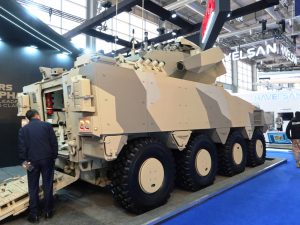
The PARS ALPHA 8×8 is fitted with new Teber-II 30/40 turret, the evolution of the Teber-30 that was unveiled in 2017. Provided in manned and unmanned versions, details of the Teber-II 30/40 can be found in the specific article, the prototype shown t WDS being fitted with the unmanned version.
A flexible platform, FNSS is already proposing it with third parties big calibre turrets, armed with 105 or 120 mm guns, 120 mm mortar turreted systems, SHORAD air defence systems, multiple rocket launcher pods, as well as an engineer version and a command post. Tube artillery is not excluded considering the growth potential.
According to information obtained by EDR On-Line more than one prototype of the PARS ALPHA was produced since the programme was started in 2020, all tests by Turkish SSB being completed, the vehicle being proposed for the Next Generation Wheeled Armoured Vehicle (NG-WVA) along with the PARS IV. All tests were conducted according to NATO standards, and the proposal has now been submitted to the Turkish authorities. It is to note that for the NG-WVA the Turkish Land Forces require a 35 mm turret, hence the Teber-II 30/40 exhibited at WDS is definitely aimed at export.
According to FNSS CEO and General Manager the PARS ALPHA concept will generate a family of vehicles, the 6×6 member being already in the pipeline, however priority was given to the 8×8 as urgent requirements were on the table, both in Turkey and in the Middle East, the launch in Saudi Arabia of the new product being an obvious indicator. Mr. Kurt also underlined that the PARS ALPHA architecture is also well suited for the adoption of a hybrid propulsion solution, announcing that both the 6×6 and the hybrid solutions will appear “very soon”.
Photos by P. Valpolini



